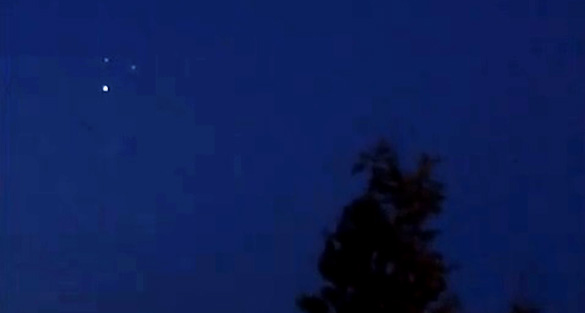Three Alleged International UFO Crashes
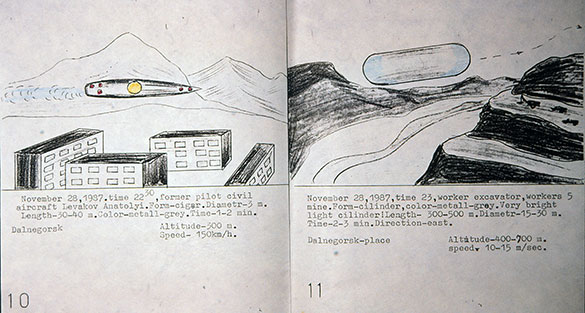
They allegedly came from Space, appeared metallic, and prompted official investigations. Were the mystery objects downed in Canada, Bolivia, and Russia genuine UFOs or some sort of secret space probes?
There are dozens of reported downed UFOs around the globe—some better documented and more credible than others. This article will address three of the best international cases including the unknown “dark object” that splashed off the Atlantic Coast near the small fishing village of Shag Harbour in Nova Scotia, Canada, on October 4, 1967; the powerful impact of an unknown space object in a remote mountainous area in Bolivia’s Tarija Department, on May 6, 1978; and the crash of a mysterious probe on Hill 611 in the Russian Pacific city of Dalnegorsk on January 29, 1986.
Shag Harbour, Nova Scotia, Canada, 1967

Dozens of witnesses saw unidentified lights falling into the Atlantic Ocean on the southeastern coast of Nova Scotia, Canada, on the night of October 4, 1967. The investigation and search effort to recover debris involved Canadian military and police agencies, including the Royal Canadian Mounted Police (RCMP), the ‘Air Desk’ at the Royal Canadian Air Force (RCAF) in charge of UFO investigations, and the Coast Guard and Royal Navy Maritime Command, which coordinated a search effort with divers. Although widely reported by the media at the time, the case was quickly forgotten until 1993, when Halifax researcher Chris Styles began a new investigation into the incident.
Shag Harbour, as the case has come to be known, has a unique advantage over other alleged UFO crashes because, as Styles states, it offers an “official paper trail.” These are genuine officially released Canadian government documents, not some disputed memos commonly found in ufology. That’s why when a book about this incident, Dark Object, was published in 2001 by Styles and coauthor Don Ledger, it carried the subtitle of, “The World’s Only Government-Documented UFO Crash.”
A “Priority” telex to Canadian Forces Headquarters, dated October 5, 1967, titled, “UFO Report,” tells the story succinctly:
Night clear, no Moon. Cpl. (Corporal) Wercicky [sic] RCMP Barrington Passage outside Lower Woods Harbour, [Nova Scotia] & other witnesses – names known to RCMP Cpl. – dark object – in excess of 60 ft. – 4 white lights horizontally 15 ft. spacing – movement easterly low altitude down to water surface unknown but in excess of five minutes UFO descended rapidly to water with high whistling sound. Bright flash on hitting water. Single light floating on surface remained for long time sank before RCMP could get boat to it. Area searched extensively by [Canadian Coast Guard] lifeboat 101 and many small boats – nil results. Position of last sighting 4330.5N 6545W. All other possible leads ([aircraft], flares, etc.) checked – nil results. Follow up: at 03:21:57 Coast Guard Cutter 101 proceeding to area with RCMP on board to research area based on A/Ref Baton Point.
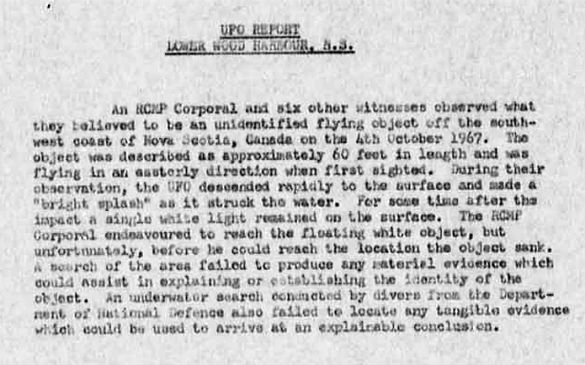
I know his case quite well as I visited the area twice, once in 1996 and again in 2003, interviewing Styles and a couple of witnesses, including retired RCMP officer Victor Werbicki, who was one of the first Mounties to arrive on the scene. In a telephone interview from his home in Alberta, Werbicki stated,
From my investigation and talking to many people, some good witnesses who saw the object, I sincerely felt that something fell down, but we could find no evidence. It came down at an angle supposedly at the channel, it was just unexplained. I was convinced, and I still am, that these people were sincere. I was convinced from all the witnesses that something came down and I don’t know what.
Most accounts place the beginning of the Shag Harbour incident around 11 p.m., when dozens of fishermen and some policemen saw lights plunging into the ocean. Their initial reaction was that an airplane had just crashed. Many vessels rushed to the spot, expecting to rescue survivors, but instead found the whole area covered with yellow foam. One of the documents uncovered by Styles, however, was a report by Leo Howard Mersey, captain of the J.B. Nickerson ship, who saw a UFO in the area a couple of hours earlier, adding that the object was also detected by the ship’s radar. Mersey’s report to the RCMP detachment in Lunenburg described the sighting:
At about 9 PM, on the 4 OCT 67, I noticed an object with three flashing red lights. Radar indicated this object to be sixteen miles away. It was very clear that night and we could see the lights of Halifax. At the time our boat was 32 miles south of Sambro Light and the object was approximately 16 miles north east of us… At the same time there were three other objects on the radar and about 6 miles from the first object. I would say it disappeared about 11:00 PM, when it went up in the air. I could not see any shape or form to it because of the distance. When it went into the air it only had one flashing light. While the object was on the water, or close to the water, it had three real bright flashing red lights… It is not unusual to see the Navy, or aircraft, dropping things into the water there. I had never seen anything like that before but it sounds like the thing they are looking for down off Shelburne or Barrington Passage. When the object left it went straight up in the air with only one red light.
Other witnesses pick up the story about fifteen minutes later, as summarized by Chris Styles, “It began sometime after 11 o’clock October the 4th, which was a moonless clear night. People who were driving or in the area began to notice that there was a set of flashing lights in the sky…most of them reported four, some of them saw them at a sharp angle and saw only three.” The witnesses called the RCMP, and when three officers arrived on the scene, “they could still see a pale yellow object moving on the water that looked unusual, it was leaving a trail of refuse, heavy yellow foam on the surface of the water.” Lawrence Smith, the first seaman to reach the impact area, received a phone call and rushed to the dock, “and got on my boat and then proceeded onto the sea, to the area where this object had gone in the water. I saw like a foam on the water, a long strip of foam, long and narrow, and that’s all I saw that night.”
The search continued the following day and the Canadian Navy arrived at noon on October 6—by this time the event was making headlines in the Canadian press. The Chronicle Herald of Halifax had the banner headline: “COULD BE SOMETHING CONCRETE IN SHAG HARBOR UFO—RCAF.” Other papers talked of a “Hunt for Saucer,” and the Canadian Broadcasting Corporation showed newsreels of the navy divers. “The Canadian naval search lasted until Sunday evening,” said Styles, “when the Maritime Command announced that the official naval search was canceled, but many witnesses seem to imply there was some kind of search effort going after that. The stated results of the military search was no results, they had recovered no debris and had no explanation for the object.”
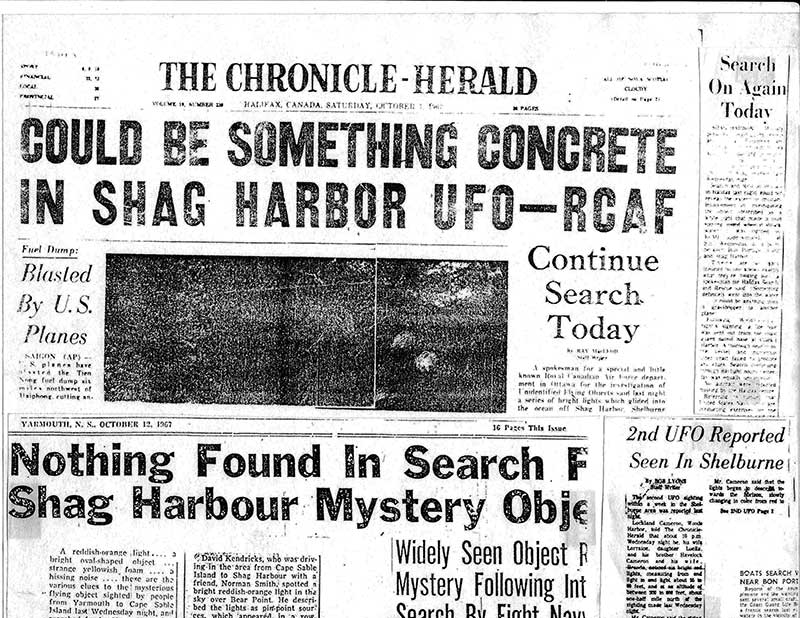
An official memorandum from Col. Turner, Director of Operations at the RCAF Air Desk, summarized the official results: “The Rescue Coordination Centre conducted preliminary investigation and discounted the possibilities that the sighting was produced by an aircraft, flares, floats, or any other known objects.” While the first phase of the Shag Harbour incident can be documented officially, another part of the story is still shrouded in mystery. Styles’ investigation turned up a complex plot involving a second, secret search effort several miles north near Shelburne, next to a then top secret submarine detection base run jointly by the U.S. and Canada, Canadian Forces Station (CFS) Shelburne, which closed down a few years ago. Because he doesn’t have the same level of official documentation, Styles refers to this episode as “the story.” It was told to him confidentially by some divers and other retired military sources.
According to this version, as Styles wrote in a paper for the 1996 MUFON UFO Symposium Proceedings, the crippled UFO that plunged into the ocean near Shag Harbour, “navigated its way, while submerged, to a point on the seabed which lay off Shelburne County’s Government Point.” He continued,
A flotilla of ships sat over the submerged UFO. Consideration was given to the possibility of attempting a recovery operation. Procrastination was due to the fact that a second UFO was on the scene repairing the first crippled craft. The Naval operation would continue for seven days. It remained a mission of observation only. On the seventh day a Soviet submarine violated the former twelve-mile international limit and began to close on the UFO’s position. The surface ships sailed towards the approaching intruder to show challenge. Shortly thereafter, both UFOs began moving while still submerged towards the Gulf of Maine. Later in open water they surfaced, became airborne, and then flew away at high speed. The story also claims that in spite of public denials from Maritime Command, debris was recovered at the Shag Harbour impact site. The Styrofoam-like and aluminum-like debris was collected and driven to the Defense Research Establishment facility in Dartmouth, Nova Scotia.
Styles concluded:
I really have trouble explaining this in conventional terms. I really try to avoid speculating, but I do feel that when you look at all the composite of evidence from the multiple witnesses, from the military response, from the implications of the physical evidence, I think it’s pretty suggestive that something, either extraterrestrial, extra-temporal or extra-dimensional is responsible. I opt for extraterrestrial myself, and that opens of course a myriad of other questions, but it did imply a nuts and bolt object that was both aerodynamic and hydrodynamic.
In 2003, an official Canada Post stamp was issued to commemorate this mysterious and still unresolved UFO case.

Tarija Department, southeastern Bolivia, near the border of Salta Province, Argentina, 1978
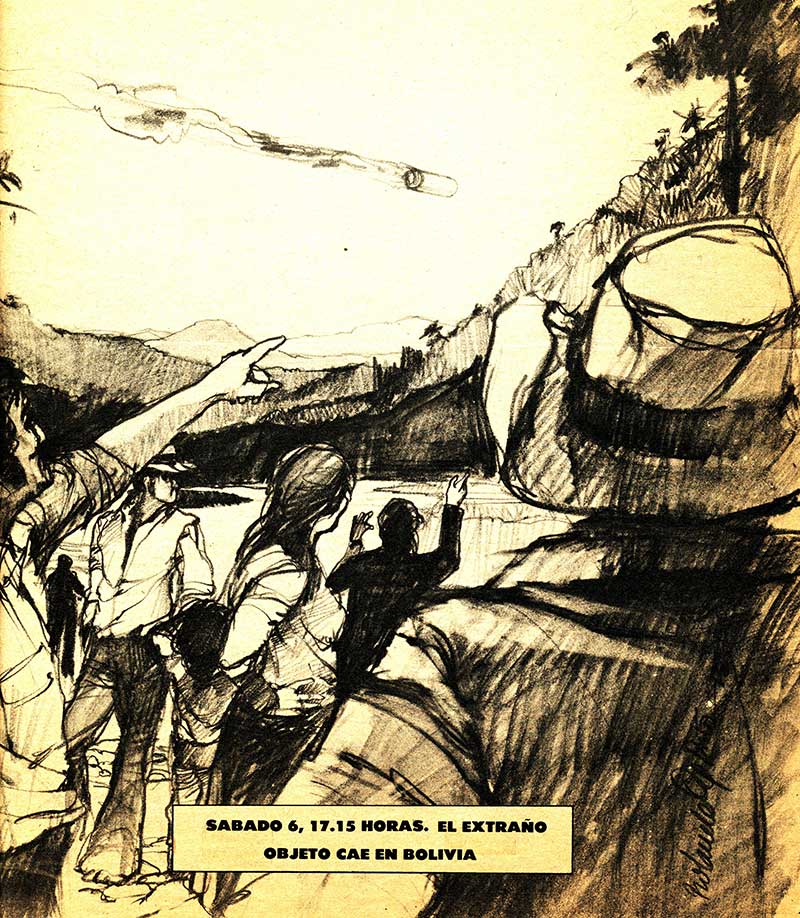
The Tarija case is probably South America’s best documented and most credible UFO crash incident. There were dozens—probably hundreds—of eyewitnesses who saw a cylindrical-shaped object spewing smoke across the sky on the mid-afternoon of May 6, 1978, and crash on a remote mountain near the Bermejo River, which separates the border between Bolivia’s Tarija Department and Argentina’s Salta Province. Others heard a loud explosion—a sonic boom heard that was heard within 120 miles that shattered windows of villages over 30 miles from the target site. Some saw a thick column of smoke rising from a mountain known in Argentina as El Taire, or El Zaire, and in Bolivia as Cerro Bravo. Although the incident was widely reported in the South American press, there was a great deal of confusion about the facts. For days it wasn’t clear if the space object had crashed in Bolivian or Argentinean territory, and there was further confusion about its origin—whether it was a meteorite, a man-made space probe, or a real UFO.
The involvement of the U.S. government in this affair provided additional intrigue. The South American press kept mentioning the arrival of NASA experts at the area, and two American military officers in civilian dress were photographed by the local press as they arrived in Tarija supposedly “on vacation.” Some reports allege that metallic fragments and even a large capsule were retrieved and quickly moved away in a U.S. Air Force Hercules cargo plane; other reports claim this was not true, and that something may still be buried under a rock slide. Yet the participation of American officials is not in doubt, as we know from a few documents released by the U.S. State Department and the U.S. Air Force that Tarija indeed came under the eye of Project Moon Dust and Operation Blue Fly—two programs headquartered at Wright-Patterson Air Force Base in Ohio, which were tasked with retrieving sensitive space debris and “Unidentified Flying Objects,” as stated in a declassified November 1961 Air Force Intelligence memo. The two American officers in Tarija were not NASA scientists, but from the U.S. Defense Attaché Office (DAO) in La Paz, acting under Project Moon Dust guidelines.
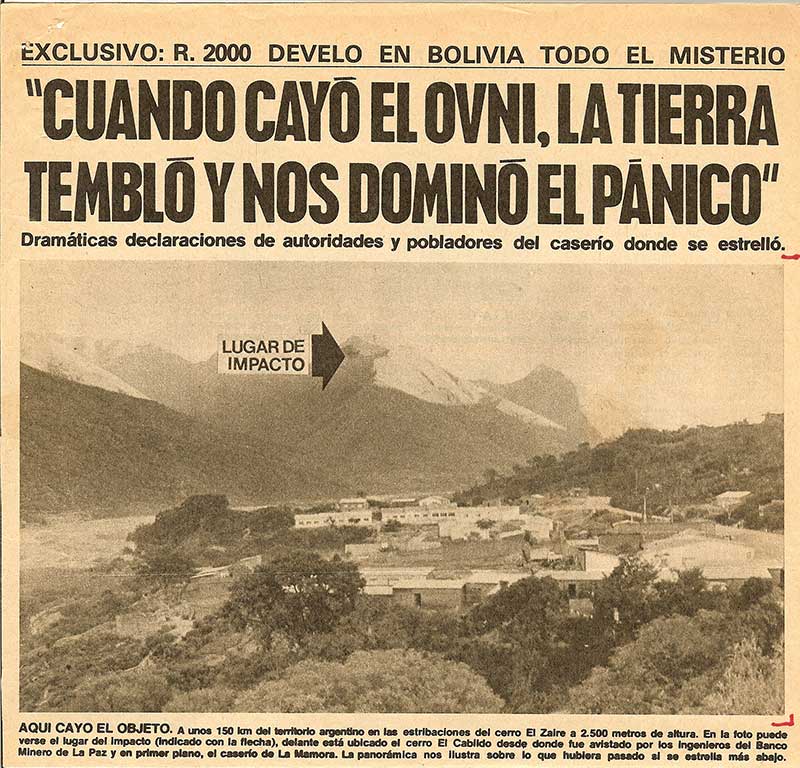
Eduardo Salmón and Bienvenido Ortega were Border Policemen with the 20th Detachment in Orán, Argentina, who were on duty in the village of Aguas Blancas on that May afternoon. A luminous flash caught their eyes, and they watched as an oval-shaped metallic-looking object crossed the sky in a northerly direction, trailing smoke. Seconds later they heard a loud explosion. The troopers were attending a soccer match, which had gathered some five hundred people at the local soccer field. Both players and spectators were astonished by the “fireball” that flew over their heads right before the explosion and the cloud of thick smoke. The closest villages to the impact area on the Bolivian side of the border were Padcaya, Mecoya, and La Mamora. Vélez Orozco was an engineer conducting a survey for a private company in Tarija when he too saw the cylindrical object. He estimated it was four meters in diameter and was conical-shaped in front. The explosion, he added, was louder than the one caused by the reentry of a meteorite a year earlier.
Corporal Natalio Farfán Ruiz was the highest military authority in La Mamora. He told Argentinean reporters:
I don’t know what would have happened if the UFO had fallen on their houses. Can you imagine? Some children live here. It was around 4:30 [p.m.] when a cylinder shook the Earth. I swear that it was horrible, I believed the end of the world was coming, but I had top have courage. After all, I was the authority.
Juan Hurtado, an agent with the Border Intelligence Service, described it this way:
It was like a huge wine container with a brilliant white color spewing smoke out of its back. I saw it quite clearly because it passed over my head. I was with three engineers of the Mining Bank in La Paz when I saw the object crash on the hill of El Zaire. The impact was so strong that it threw me down to the ground. In that moment, the whole Earth trembled.
Eventually, the Bolivian Air Force flew three single-engine AT-6 planes over the area and detected a large rockslide over the southern slopes of Cerro Bravo. The area is extremely rugged and of difficult access. Several expeditions attempted to reach the exact impact site, but only the second group, headed by Major Germán Callejas, was able to locate the rockslide around May 24. A great deal of confusion surrounded the case by that time. On May 14, the Buenos Aires newspaper Clarín reported that the object had been recovered—“a metallic-dull cylinder, four meters long and with some dents”—and that NASA officials would take charge of it. A sketch of the alleged retrieved object published by Clarín resembled a Gemini or Apollo space capsule. There was also a great deal of apprehension that it could be a Soviet nuclear satellite—Cosmos 954 had crashed in northern Canada only three months earlier on January 24, 1978. Finally, there was talk of a meteorite, although my own personal inquiries with the Smithsonian’s Scientific Event Alert Network (SEAN), which tracks natural disasters, showed no meteorite fall in Bolivia in May 1978.
The South American press was full of stories of NASA officials arriving in Tarija, but the truth is that the two military officers who showed up, Col. Robert Simmons and Major John Heisse, were most likely from the U.S. Defense Attaché Office (DAO) in La Paz, who were acting on behalf of Project Moon Dust, which oversaw the retrieval of downed space objects. We know the U.S. government was involved because at least some documents from the U.S. State Department and the U.S. Air Force were later obtained under the Freedom of Information Act. Key among these documents is a May 18 telegram, classified “Secret,” and bearing the name of Secretary of State Cyrus Vance, although it was drafted by Col. Robert Eddington from the State Department’s Bureau of Oceans, International Environment, and Scientific Affairs. The message indicated that the Tarija case, “has been checked with appropriate government agencies. No direct correlation with known space objects that may have reentered the earth’s atmosphere near May 6 can be made. However, we are continuing to examine any possibilities.” The message then referred the U.S. Embassy in La Paz to, “State Airgram A-6343 of July 26, 1973 which provides background information and guidance for dealing with space objects that have been found.” Secretary Vance concluded: “In particular any information pertaining to the pre-impact observations, direction or trajectory, number of objects observed, time of impact and a detailed description including any markings would be helpful.”
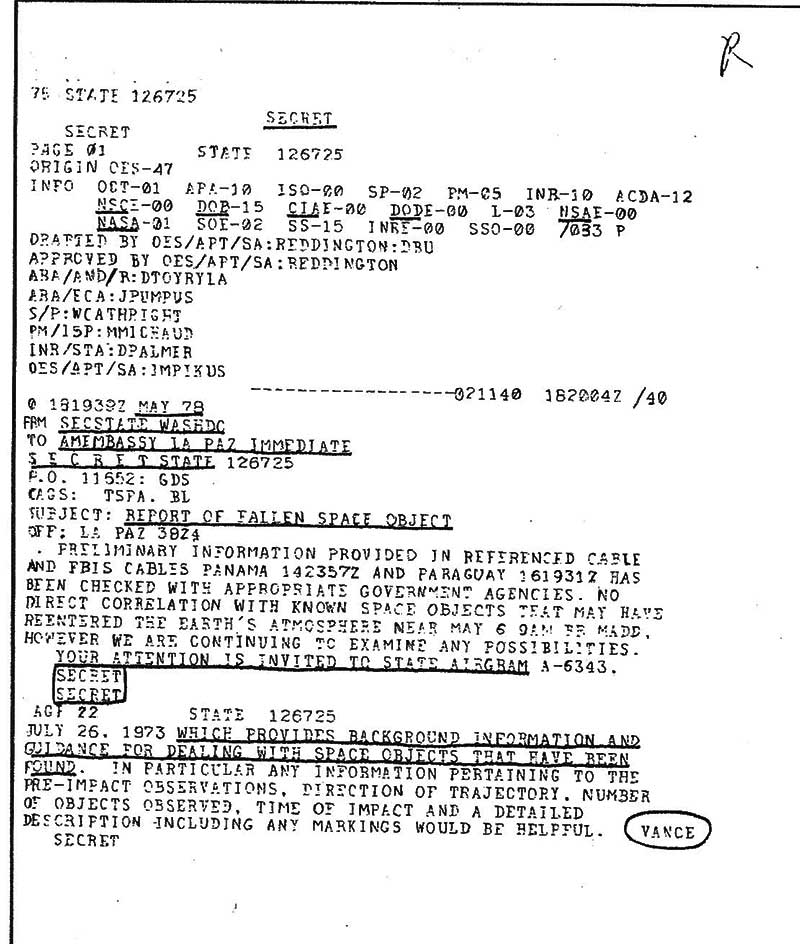
Additional data is provided by a couple of documents from the DAO in La Paz under the subject of Moon Dust. “This office has tried to verify the stories put forth in…the local press,” informed the DAO, adding that their office had contacted the chief of staff of the Bolivian Air Force and the commander of the Bolivian Army, both of whom indicated that search parties were “directed to go into the area to find the object but found nothing.” Two independent American investigators, the seasoned National Enquirer reporter Bob Pratt and Charles Tucker of the International UFO Investigating Bureau, actually visited the area and interviewed many witnesses, including the members of the Bolivian expeditions. Pratt tried to reach the crash site himself but couldn’t because of the difficulties of the terrain. In a 1984 letter, Pratt wrote that “a lot of misinformation has been published about this incident. I am certain, however, that the area was not cordoned off by the military, that no object was recovered by NASA or anyone else, that no Hercules picked up anything.” Pratt finished his letter by stating that, “I believe something crashed into the mountain and was buried under the landslide it created. But the six people I know who have personally inspected the site could find no debris of any kind. Whatever struck there is probably going to remain buried there.”
Dalnegorsk, Russian Pacific Coast, 1986
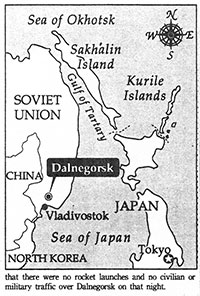 Although there are several reported UFO crashes in Russia and the republics of the old Soviet Union, the Dalnegorsk incident of 1986 is unique because it is one of the few cases where metallic fragments were recovered and analyzed by scientists with the results openly published. A number of unique circumstances made this possible. The principal investigator of the case, Dr. Valery Dvuzhilny, led a group from the Far Eastern Commission on Anomalous Phenomena, and the timing coincided with the then newly implemented policies of glasnost and perestroika issued by Mikhail Gorbachev, which allowed the publication of the case. Dvuzhilny also corresponded extensively with Western researchers, sending copies of his reports and photos of the recovered evidence.
Although there are several reported UFO crashes in Russia and the republics of the old Soviet Union, the Dalnegorsk incident of 1986 is unique because it is one of the few cases where metallic fragments were recovered and analyzed by scientists with the results openly published. A number of unique circumstances made this possible. The principal investigator of the case, Dr. Valery Dvuzhilny, led a group from the Far Eastern Commission on Anomalous Phenomena, and the timing coincided with the then newly implemented policies of glasnost and perestroika issued by Mikhail Gorbachev, which allowed the publication of the case. Dvuzhilny also corresponded extensively with Western researchers, sending copies of his reports and photos of the recovered evidence.
Dalnegorsk is a small city near Russia’s Pacific Coast, on the Sea of Japan, just north of Vladivostok. The story begins at 7:55 p.m., on January 29, 1986, with the collision of an unknown object on Hill 611 in Dalnegorsk. One of the reports by Dr. Dvuzhilny summarized the events:
Residents of the settlements observed a reddish-orange sphere the size of a half full moon, which flew from the southwest at 260 degrees. Its altitude was 700-800 meters. The flight was parallel to the surface of the Earth, without the angles which are characteristic for meteorites. The witnesses heard absolutely no noises. The calculated speed by chronometer was 15 meters per second. There was no change of direction or altitude.
The object then approached the Izvestkovaya Mountain, or Hill 611, which has an elevation of 600 meters and is located at the center of the city. “The object made a dive and went at an angle of 60-70 degrees on the cliff ledge, where it ‘fell’ and burned for an hour,” continued the report, “some of the witnesses affirm that it rose and lowered itself six times, and that its light was intensified during its rise and weakened during its lowering.” Dvuzhilny and his team arrived on the scene on February 3, finding a number of physical traces, which included lead and iron balls, bits of glass, a fine mesh or netting, traces of high temperature activity, magnetic anomalies, and damage to nearby trees and stumps.
The materials were analyzed by several laboratories and research institutes; the results were quite enigmatic, leading Dvuzhilny and other scientists to conclude that the Dalnegorsk object was probably an artificial space probe of non-terrestrial origin. According to one report published in the influential newspaper, Socialist Industry (now Rabochaya Tribuna), “in the scales (or mesh), almost all the elements of the entire periodic table were found.” Special analysis of the lead balls, for instance, showed that besides lead, they contained silicon (20%), aluminum (10%), iron (15%), zinc (1.5%), titanium (2%), magnesium (1%) and silver (2%), as well as minute portions of copper, lanthanum, praseodymium, calcium, sodium, vanadium, cerium, chrome, cobalt, nickel, and molybdenum.

The scales, or mesh, reacted in a very strange manner during the laboratory analysis. The Socialist Industry report described how one of the scientists, A. Makeev, “presented the [X-ray] structural analysis and showed that from one scale, after melting it in a vacuum, all of a sudden gold, silver, and nickel disappeared. But there appeared alpha-titanium and molybdenum. In another scale, the metals did not appear at all. And for some reason, after the heating, there appeared beryllium sulfide.”
There were still further surprises, such as “six areas of magnetized silica rock” (silica is a non-magnetic material) found on the crash site. These results were published by A. Petukhov and T. Faminskaya, members of the Council of Scientific and Engineering Sciences’ Commission on Paranormal Events. “Vivid interest was also evoked by the mesh, a carbon-based composite of unknown origin,” wrote Petukhov and Faminskaya, “the specimen was found to include quartz filaments 17 microns thick, and golden wires inside the filament.” All this evidence led some investigators to conclude that something alien had indeed crashed at Hill 611. V. Vysotsky, Doctor of Chemistry from Vladivostok, stated: “Undoubtedly, this is a high-technology product and not a thing of natural or terrestrial origin.” Dvuzhilny proposed that it was “an automatic scout probe” of alien origin, and rejected the alternative hypothesis that it could have been a natural plasmoid.
Still another hypothesis was offered by Yuli Platov, a senior researcher with the Institute of Earth Magnetism, Ionosphere, and Radiowave Propagation of the USSR Academy of Sciences as well as a noted UFO skeptic. Platov wrote that the Dalnegorsk phenomenon, “in reality was connected with the conduct of a technical experiment.” This is a polite way of saying the Hill 611 object was probably a secret Soviet military aircraft or spacecraft; yet, if this was the case why wasn’t Hill 611 immediately cordoned-off by Soviet troops and the material hushed away by the KGB? Why were scientists and technicians from the civilian, rather than the military industrial sector, allowed to conduct their investigation more or less openly and parade their puzzling results to the local and national media? Moreover, neither Platov nor anyone else ever produced any supporting evidence to back their experimental craft hypothesis. Dvuzhilny also noted that there were no rocket launches and no civilian or military traffic over Dalnegorsk on the night of January 29, 1986.
Regardless of its ultimate origin, the crash on Hill 611 was only the beginning of an intense UFO wave around Dalnegorsk. For instance, another report by Dvuzhilny indicates that, “on February 6, 1986, eight days after the UFO crash, there appeared from the north two yellow globes at 8:30 p.m. They approached the crash spot, made four circles over it and disappeared with a flash.” By and large, however, the largest display of UFOs occurred on the night of November 28, 1987. Dvuzhilny wrote: “On Saturday November 28, 1987, 33 UFOs were flying at a low height over the Eastern coast of Primorye. Their flights took place between 9:10 pm and midnight. They were of different shape: cylinders, cigars, globes. They were flying over five regions and twelve settlements.”

Inquiries made by Dvuzhilny showed there had been no flights of civil or military aircraft at that time, and that no rockets were launched from Soviet Cosmodromes. In total, thirteen UFOs flew over Dalnegorsk itself. They were seen by over a hundred witnesses, including military personnel, militia (police), border guards, and sailors, as well as all kind of civilian workers who were questioned by the Far Eastern Commission. Still more sightings occurred in the months to come. The Commission recorded forty-five UFO sightings in 1987, fifteen in 1988, and thirty-two in 1989. Statistics for the 1990s were not included in the reports sent to the U.S. by Dr. Dvuzhilny, but what was included—all the evidence reviewed here—is quite extraordinary.

THE METALLIC SPHERES – A CASE OF MISTAKEN IDENTITY
Some of the Project Moon Dust documents declassified by the Defense Intelligence Agency (DIA) include reports of mysterious metallic spheres found scattered in many countries around the world like Bolivia, Chad, and New Zealand. Other similar cases not in the DIA documents were reported in Argentina and Mexico. Usually these cases were readily identified as some kind of space junk, but occasionally they were treated as fragments from crashed UFOs. A couple of these spheres are even on display at the “Visión OVNI” (UFO Vision) Museum in Victoria in the province of Entre Ríos, Argentina. Among the Mexican cases, one was found in Chiapas in 1996, two in Tamaulipas in 1994 and 1996, and another obtained by famous TV journalist Jaime Maussán in 2008, all of which were claimed as possibly UFO-related fragments. Yet there can be little doubt that all these “space balls” are mundane parts of the Russian or American space programs and not real UFO artifacts.
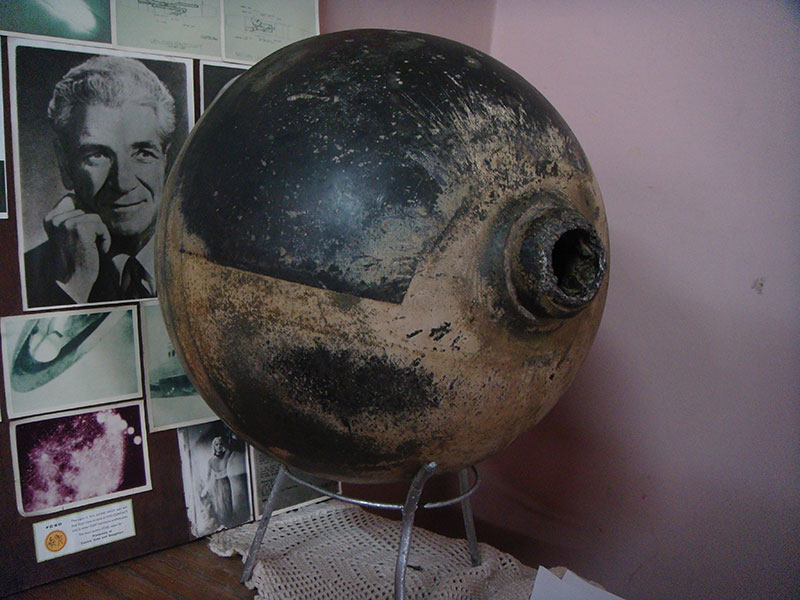
Here is a representative Moon Dust memo from the Republic of Chad in Africa, dated October 10, 1970:
This report forwards photographs of object believed to come under Project ‘MOON DUST’. The object was seen falling in an area 30 kms N.E. of LAI (0924N-1618E) on 1 August 1970. It produced three loud explosions on landing and was said to have burned for five days. The sphere weighs 30 pounds and has a circumference of four feet. A second object was found in the same general area. It however, resembles au automobile shaft. Photographs of this object are forwarded.
A longer Moon Dust document, dated August 17, 1979, concerns “an unidentified object having been found on a farm near Santa Cruz” in Bolivia, described as “about three times the size of a basketball.” The document quoted the director of the Air Force Academy, Col. Ariel Coca, as stating, “The sphere is made of special light ally but very resistant, possibly a fuel tank or a part of a satellite! The object does not have any signs or marks that could identify its origin nor the country to which it belongs.”
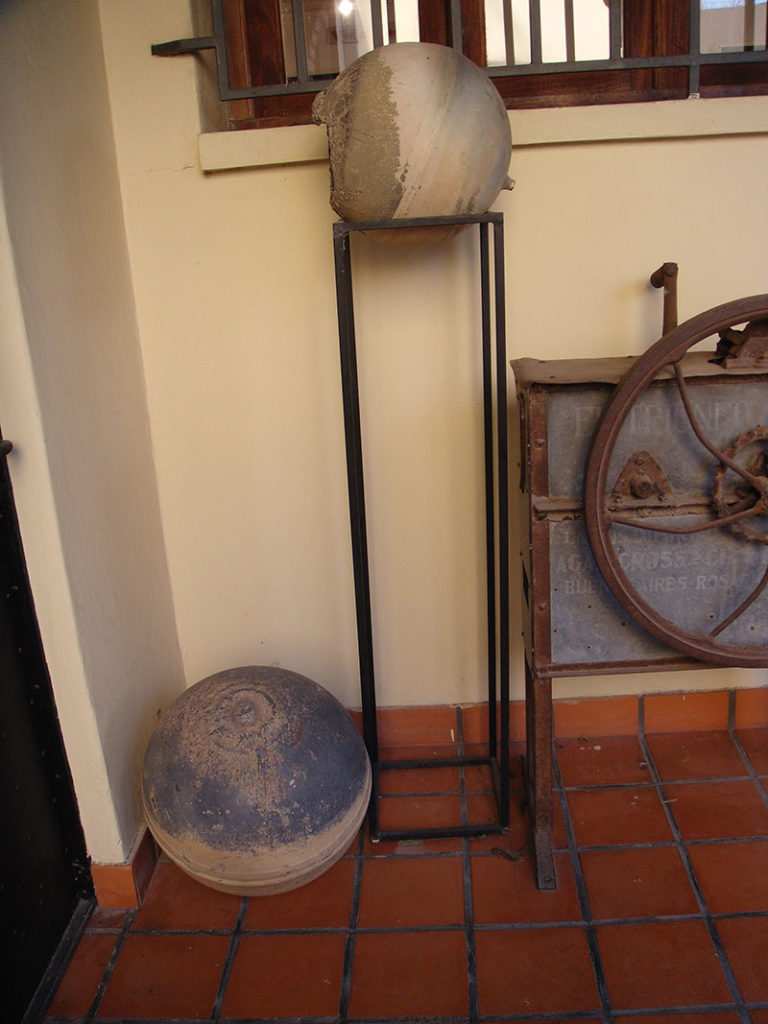
The argument in favor of the extraterrestrial origin of these spheres made by some ufologists in Mexico and Argentina is that they are extremely hard, almost impossible to burn or cut. But this is what you would expect of a fuel tank for a spacecraft, designed to be ejected for earth reentry once the fuel is used; it has to be made of metals able to withstand the space launch or the satellite or spacecraft could be in danger. Mexican engineer Luis Ruiz Noguez, a well-known UFO skeptic, explained that the alloy, which is composed of titanium, vanadium, and aluminum, shown in the 1994 and 1996 Mexican spheres “is chiefly utilized in the manufacture of fuel tanks for artificial satellites due to their high resistance to corrosion and temperature.” While the spheres at Argentina’s Visión OVNI Museum are exhibited as true UFO artifacts, another local museum in Paraná has a couple of similar spheres that the Russian space program has acknowledged as part of a Russian space probe.
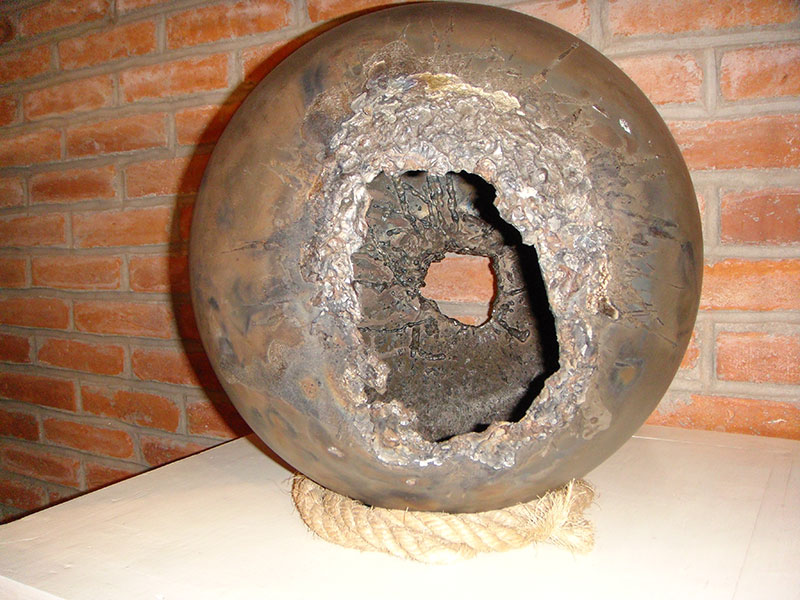
These spheres provide a useful cautionary tale in learning how to distinguish prosaic man-made space objects from true unknown devices. There is a good possibility that many so-called UFO crashes have a terrestrial origin, but others are still enigmatic and so far unexplained.
A version of this article originally appeared in Issue #8 (June/July 2011) of Open Minds UFO Magazine. Back issues can be found here.




